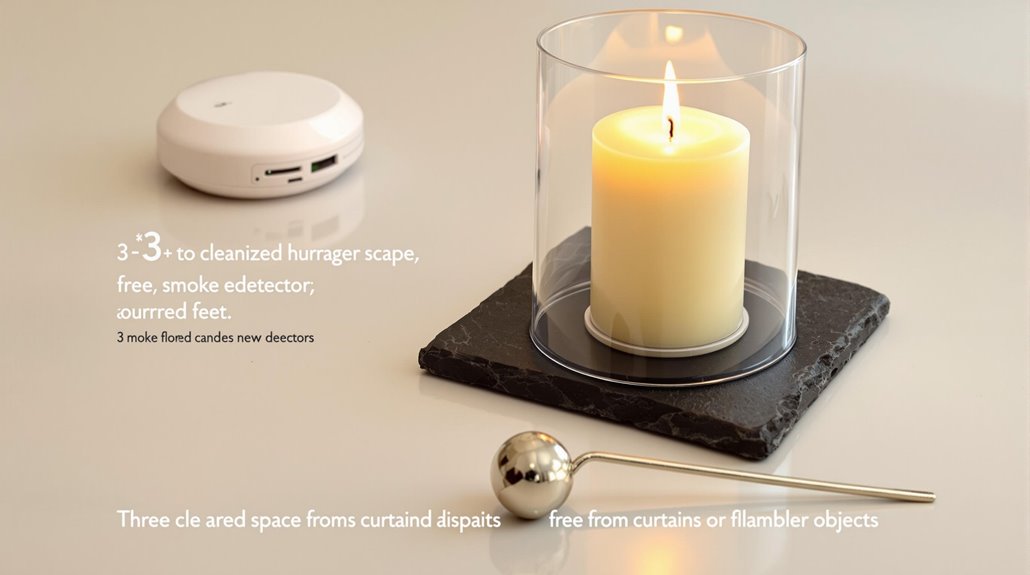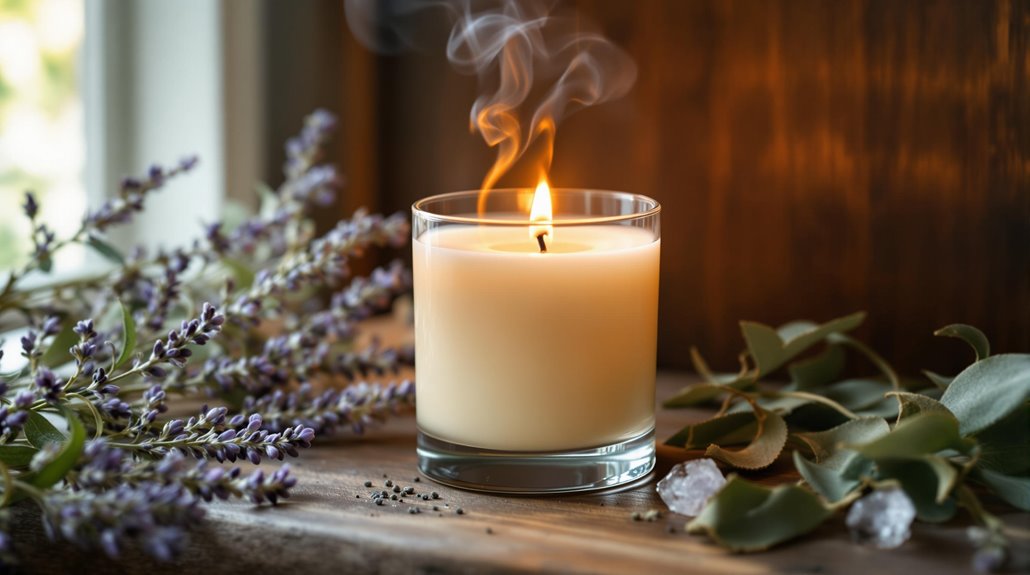The History of Candle Making: From Ancient Times to Modern Day
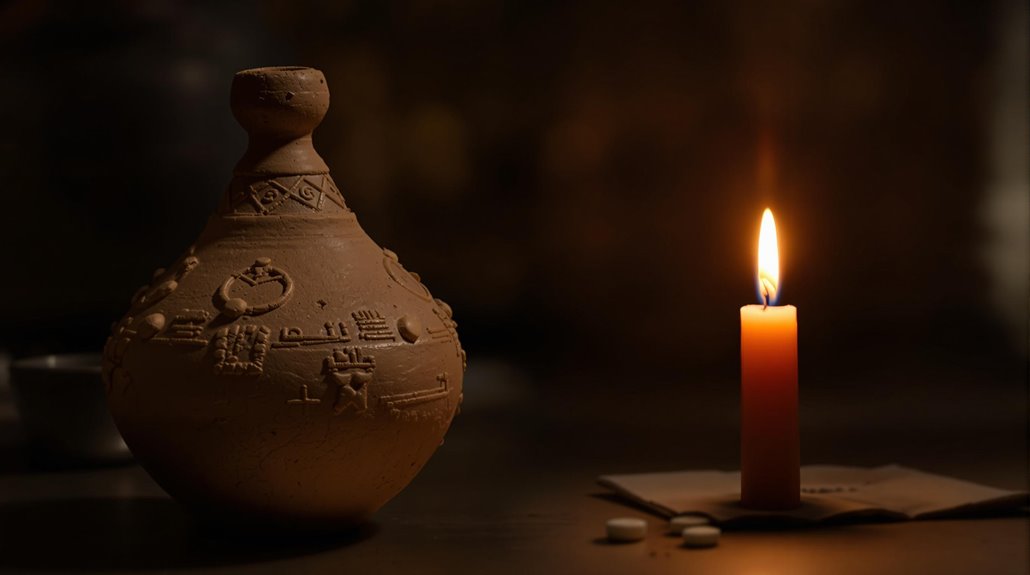
Tracing its origins to ancient civilizations, candle making has evolved over millennia. From primitive wicks of reeds and straw to modern advancements in wax and fragrance, the candle industry has seen remarkable transformation. Ancient Egyptians, Greeks, and Romans incorporated candles into religious rituals and daily life, using tallow and beeswax. The Industrial Revolution ushered in mass production techniques and paraffin wax. Today, candles are prized for their aromatherapy benefits, with sustainable soy and plant-based waxes. As you explore further, you'll uncover the rich history and continued innovation behind this enduring light source.
Origins of Candle Making
The origins of candle making can be traced back to ancient civilizations, where people developed innovative methods to illuminate their environments. In those early days, primitive wick materials like reeds, straw, and even rolled papyrus were used to create simple candle-like devices, which were often fueled by natural wax sources such as beeswax, tallow, and even whale fat.
As civilizations progressed, candle making evolved, with the exploration of new wax materials and the refinement of wick technologies. The ancient Egyptians, for instance, are credited with using beeswax and tallow to produce some of the earliest known candles. Meanwhile, the ancient Chinese developed candles from whale fat, and the ancient Romans employed tallow and beeswax, often scenting their candles with aromatic herbs and oils.
These early candles not only provided light but also became symbols of wealth, status, and religious significance, laying the groundwork for the rich history and diverse applications of candle making that are familiar to us today. The craft has since transformed into a therapeutic pastime that brings warmth and serenity to modern spaces.
Ancient Egyptian Candle Traditions
Among the ancient civilizations that contributed to the evolution of candle making, the Egyptians stand out for their innovative approaches. In ancient Egypt, candles were not just a practical light source, but also held deep spiritual significance.
The Egyptians employed several ancient Egyptian lighting methods, including:
- Tallow candles made from animal fat
- Rush lights, which were reeds dipped in wax or tallow
- Oil lamps fueled by animal or vegetable oils
These lighting sources played a vital role in religious ceremonies involving candles, where they were used to illuminate sacred spaces and rituals. The flickering flames were seen as a connection to the divine, and candles were often placed in tombs and temples to guide the deceased on their expedition to the afterlife.
The Egyptians' expertise of candle making techniques and their reverence for the power of light have left a lasting impression on the history of this enduring craft. Similar to how sandalwood incense burning promotes mental clarity and calmness, the ancient Egyptians believed their candles created a serene atmosphere for spiritual practices.
Candle-Making in Ancient Greece and Rome
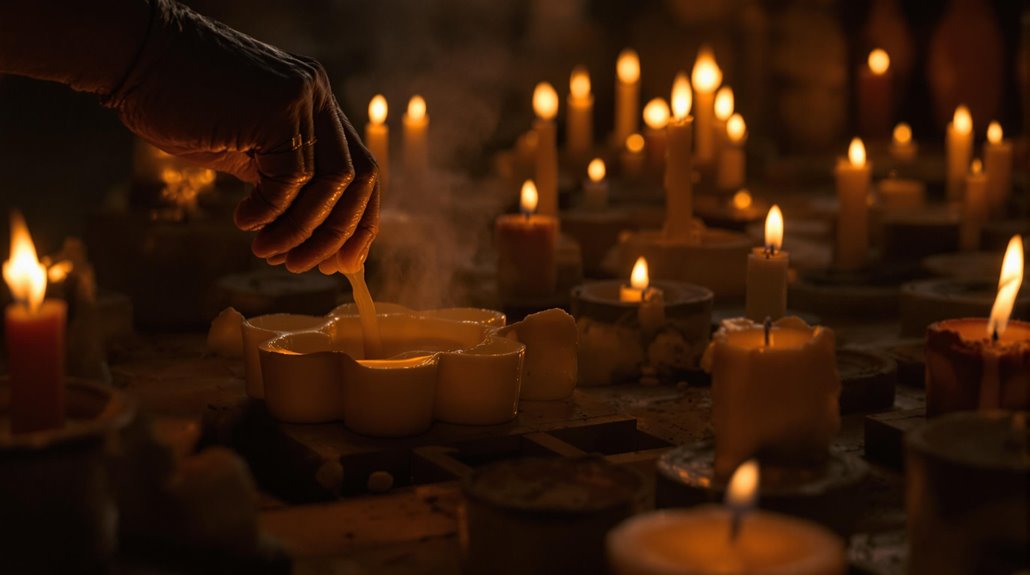
While the Egyptians pioneered candle-making, the ancient Greeks and Romans further developed this illuminating art. In Greece, candles were used extensively in religious rituals, from lighting shrines to guiding processions. The Greeks also employed candles for decorative purposes, crafting ornate holders to showcase the flickering flames. Over in Rome, the practice of candle-making flourished, with beeswax and tallow serving as the primary materials. Romans incorporated candles into their daily lives, using them to light homes, guide travelers, and even mark the passage of time.
Candles became a symbol of status, with the wealthy adorning their abodes with intricate designs. As the Roman Empire expanded, the art of candle-making spread throughout the Mediterranean, influencing the techniques and styles of neighboring civilizations. The legacy of ancient Greek and Roman candle-making endures, shaping the way we illuminate our world even today. Their artistic influence can still be seen in modern candle chandeliers, which combine classical elegance with the timeless appeal of flickering flames.
The Rise of Tallow Candles
As the ancient Greeks and Romans refined the art of candle-making, a new material emerged that would come to dominate the scene: tallow. Tallow, a byproduct of animal fat, became the primary ingredient in the production of candles, ushering in the rise of tallow candles.
The evolution of tallow candles was marked by several key developments:
- Improved production methods: Tallow candles were initially crude and smoky, but over time, manufacturers uncovered techniques to refine the tallow, resulting in cleaner-burning and longer-lasting candles.
- Widespread availability: Tallow was a readily available and inexpensive material, making tallow candles accessible to a broader range of people, from the wealthy to the common household.
- Technological advancements: The introduction of wick-trimming tools and molds helped to standardize the size and shape of tallow candles, leading to more consistent quality and burn times.
The rise of tallow candles marked a significant shift in the history of candle-making, opening the door for the development of more advanced lighting solutions in the centuries to come. Much like Indian sandalwood oil which commands $2,000 per kilogram, quality tallow became a valuable commodity in the candle-making industry.
Advancements in Wick Design
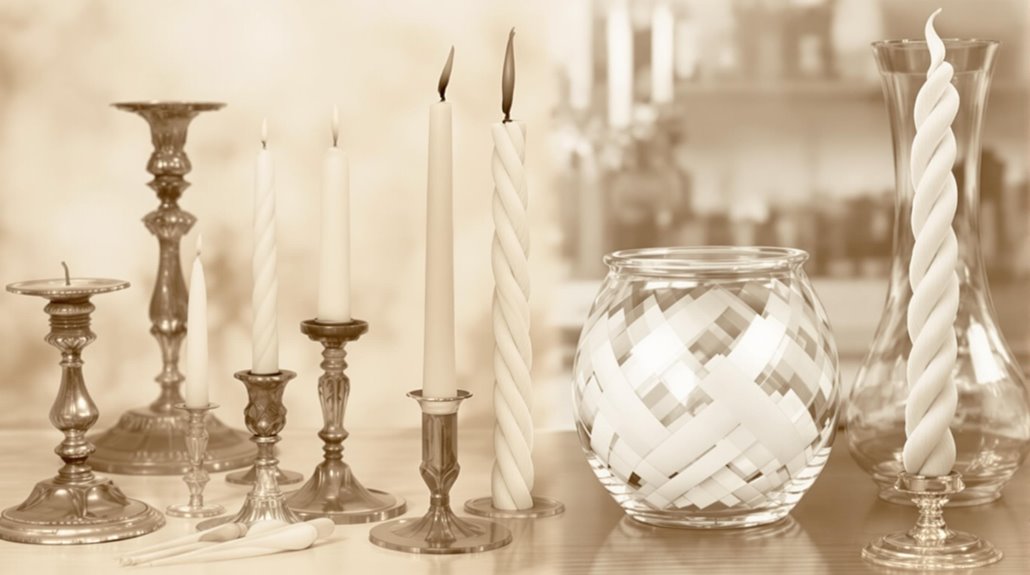
The advancements in wick design played an essential role in the evolution of tallow candles. As the demand for more efficient and longer-lasting light sources grew, candle makers began experimenting with wick composition and manufacturing techniques. They uncovered that using cotton fibers instead of plant-based materials like rush or papyrus improved the wick's burn rate and stability. Further refinements, such as braiding or twisting the wicks, helped them maintain an upright position and prevent excessive curling or dripping.
The introduction of the flat-braid wick was a transformative development, as it allowed for a more controlled and even flame. This design feature, combined with the use of more refined tallow or wax, resulted in candles that burned cleaner, brighter, and longer than their predecessors. Additionally, the development of automated wick-making machines streamlined the production process, making candles more accessible and affordable for the masses. Modern candle makers often choose natural wax options like soy, beeswax, or coconut wax over traditional paraffin due to health and environmental concerns.
The Emergence of Beeswax Candles
Alongside the advancements in wick design, another significant development in the history of candle making was the emergence of beeswax candles. Unlike tallow candles, beeswax candles burned cleaner, longer, and emitted a more pleasant aroma. This shift in candle-making was driven by improved beeswax production methods and purification techniques.
The key benefits of beeswax candles include:
- Cleaner Burn: Beeswax candles produce less soot and smoke compared to their tallow counterparts, making them a more desirable choice.
- Longer Burn Time: Beeswax has a higher melting point, allowing beeswax candles to burn for a longer duration.
- Natural Fragrance: The natural aroma of beeswax provides a subtle, pleasant scent that enhances the ambiance of any space.
As the demand for these superior candles grew, candle makers refined their beeswax purification processes, ensuring a consistent and high-quality product. This shift marked a significant advancement in the history of candle making, facilitating the widespread use of beeswax as a premium candle material. Modern research has shown that beeswax candles release negative ions during burning, contributing to improved air quality in indoor spaces.
The Industrial Revolution and Candle Production
During the Industrial Revolution, candle production underwent a significant change. Manufacturers began to employ mass production techniques, allowing them to churn out candles at a faster rate than ever before. Gone were the days of painstakingly hand-dipping each candle - instead, they relied on mechanized processes to streamline the operation.
Innovative fuel sources also emerged during this era. Tallow, a by-product of the meat industry, became a popular choice, as it was more affordable than beeswax. Paraffin wax, derived from petroleum, also entered the scene, offering a cleaner-burning and longer-lasting alternative. These new materials, combined with industrialized methods, enabled candle makers to meet the growing demand for illumination in homes, factories, and public spaces.
The Industrial Revolution truly revolutionized the candle-making industry, altering it from a cottage craft into a large-scale enterprise. This period paved the way for the mass-produced, widely available candles that are known and used today. Today's modern candle manufacturers often use natural soy wax to create more environmentally-friendly alternatives to traditional paraffin candles.
Scented Candles and Aromatherapy
Aromatherapy has emerged as an engaging avenue for candle makers to investigate. By incorporating essential oils and fragrance blends, scented candles can now offer a multi-sensory experience that goes beyond the simple glow of a flame.
Scented candles provide three key benefits:
- Relaxation - Essential oils, such as lavender and chamomile, can have a calming effect when released into the air.
- Mood Enhancement - Uplifting scents like citrus or peppermint can energize and invigorate the senses.
- Ambiance - The right fragrance blend can instantly alter the atmosphere, setting the mood for a cozy evening or a rejuvenating morning.
As consumers increasingly seek natural, wellness-focused products, the demand for high-quality, artisanal scented candles has soared. Candle makers who excel at the art of essential oil blending and fragrance layering can capitalize on this growing trend, offering customers a unique sensory experience that nourishes both body and soul. The therapeutic properties of these candles are enhanced when crafted with sustainable wax options like soy, beeswax, or palm wax blends.
The Modern Candle Industry
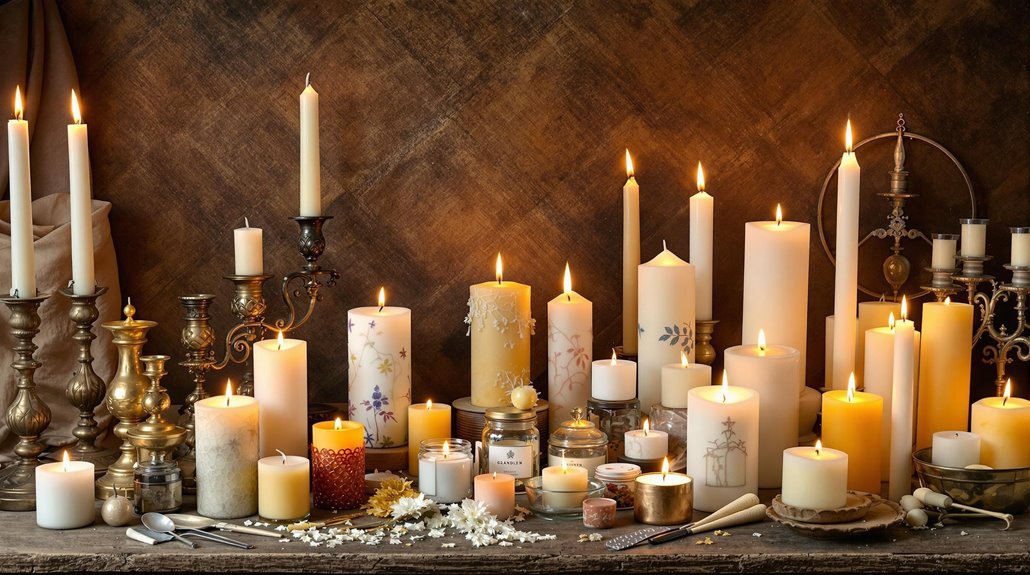
The modern candle industry has undergone a noteworthy change, adapting in step with the increasing consumer demand for sustainable, eco-friendly products. Manufacturers have implemented various sustainability initiatives to address this shift in consumer preferences. They've introduced soy-based and plant-based waxes, which are renewable and biodegradable alternatives to traditional paraffin wax. Additionally, many companies now offer lead-free cotton wicks, ensuring a cleaner burn and eliminating potential toxins. Candle lovers also seek out products with natural essential oils and dyes, eschewing synthetic fragrances and colorants. In response, brands have expanded their products of scented candles made with pure, ethically sourced ingredients.
The industry has further welcomed environmentally-conscious packaging, using recyclable materials and minimizing waste. As sustainability becomes a driving force, the modern candle market caters to conscientious consumers who prioritize natural, renewable, and socially responsible options. The shift toward natural ingredients addresses growing concerns about indoor air pollution caused by synthetic fragrances and paraffin-based candles.

